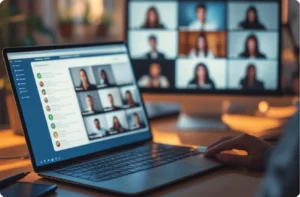LMS Gamification: Boost Learner Engagement with These Must-Have Features
When traditional training methods don’t engage your workforce and completion rates are below 30%, you need proven strategies to turn passive learning into active participation, so you can finally see ROI from your training investments.
The problem is clear: employees view mandatory training as a chore, not an opportunity. Despite investing in learning management systems, most organizations struggle with low engagement and poor completion rates.
The solution is gamification features that tap into human psychology. Modern learners expect their professional development to be as engaging as the apps they use daily.
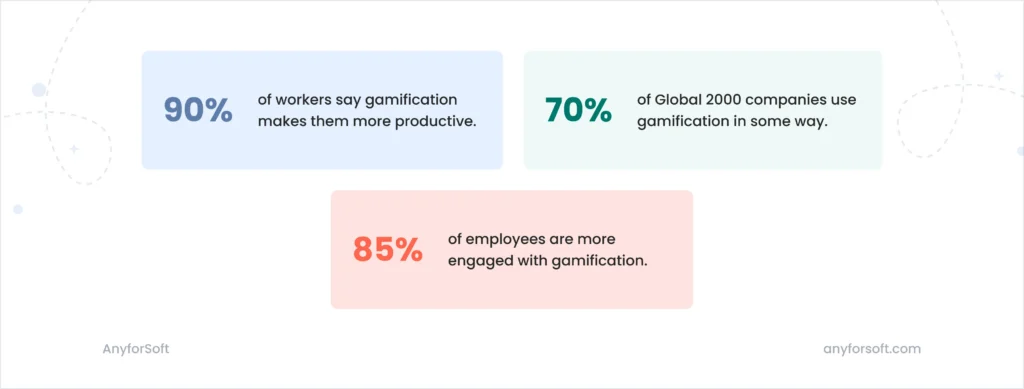
The numbers prove it works:
- 90% of workers say gamification makes them more productive.
- 70% of Global 2000 companies use gamification in some way.
- 85% of employees are more engaged with gamification.
At AnyforSoft, we’ve seen how gamification changes both learner behavior and business outcomes. The key is to align game mechanics with what learners need: skill development that’s efficient and keeps them engaged.
From this article, you’ll get:
- Gamification features that work
- Game design elements that maintain long-term motivation
- Top platforms with points and badges systems
- Proven implementation strategies.
Ready to kick your learning platform up a notch? Then keep reading!
2nd option
When your organization faces declining completion rates and low employee engagement in mandatory training programs, you want to find proven ways to turn boring content into engaging experiences so you can finally see ROI on your learning investments.
Traditional training methods do not meet the expectations of today’s learners, resulting in low completion rates and minimal knowledge retention across various industries. The solution lies in gamification features that turn passive learners into active participants who actually want to engage with your content.
9 out of 10 employees say gamification boosts their productivity. According to amplifAI, 90% of workers believe gamification enhances their productivity in the workplace. Introducing gamified elements into everyday tasks has been proven to motivate workers in new ways, making routine tasks more enjoyable. In fact, employee engagement statistics show that 85% of employees are more engaged with gamification. What does this tell us? Super simple – it’s about how people expect to learn these days.
At AnyforSoft, we specialize in LMS development services and have seen firsthand how gamification systems transform learning platforms. Through our experience building solutions for the e-learning industry, we’ve learned what makes learners engaged and drives real results.
In this guide, you’ll discover:
- What LMS gamification is.
- How gamification features turn traditional training into engaging experiences.
- Essential game design elements that keep learners engaged.
- Top LMS platforms that integrate points and badges systems.
Ready to turn your learning technology into something people actually want to use?
3d option
Learning and development professionals face a constant challenge: creating training experiences that employees actually want to complete. Despite investing in learning management systems and content development, many organizations struggle with completion rates below 50% or 30% and learners’ perception of mandatory training as something boring, necessary, and time-consuming.
When traditional training methods don’t engage your workforce and learning initiatives underperform, you need a systematic approach to turn passive content consumption into active, motivated participation. The answer lies in gamification features that tap into human psychology to create learning experiences people actually want to engage with.
It’s not about superficial point systems or meaningless badges, but about creating learning environments that meet the core goal learners are trying to achieve: gain knowledge and skills efficiently while staying engaged throughout the process. Today’s learners, shaped by interactive digital experiences, expect their professional development to be as engaging as the apps and platforms they use every day.
The numbers are clear:
9 out of 10 employees say gamification boosts their productivity. According to amplifAI, 90% of workers believe gamification enhances their productivity in the workplace. In fact, employee engagement statistics show that 85% of employees are more engaged with gamification. What does this tell us? Super simple – it’s about how people expect to learn these days.
At AnyforSoft, through our experience developing learning management systems, we’ve seen how strategic gamification changes both learner behavior and business outcomes.
So, this guide will show you how to implement gamification elements that serve a purpose: make learning more effective, engaging, and aligned with how people naturally want to progress and achieve mastery. You’ll discover the must-have features that turn learners into motivated ones who actively seek out new training opportunities.
What is LMS Gamification?
LMS gamification adds game-based elements to learning platforms to create more engaging learning experiences. These elements include achievement points and badges, leaderboards, progress indicators, mini-games, quizzes, and interactive challenges.
The goal behind gamifying an LMS is to make learning content more engaging, fun, and effective. When done right, gamification techniques greatly enhance the training experience and user engagement.
For example, leaderboards introduce competition to your learning programs, motivating learners to study harder to outperform their colleagues. You can use badges to give learners a sense of achievement and consistent effort.
But here’s what most organizations miss: effective gamification systems aren’t about adding superficial rewards to existing content. They’re about designing learning activities that tap into intrinsic motivation and create meaningful progress.
Benefits of Gamification in LMS
Some time before, in one of our previous articles, we discussed gamification in e-learning and the multiple benefits it brings. Now, let’s take a look at the advantages of gamification in LMS.
You may think: “Why are so many organizations implementing gamification into their training programs? Is it because an LMS with gamification is more effective than one without?”.
Our experts answer shortly – yes. And to find out why gamified learning management systems work better, let’s look at the benefits of gamification.
- Better training for corporate learning
Gamification features don’t just make training more fun – they measurably improve outcomes. Employees and learners who study in gamified environments perform better on tests and practical applications than those using traditional methods.
A well-designed gamification system helps to increase the effectiveness of your corporate learning and reach specific training goals with measurable results.
- Enhanced learner engagement through interactive elements
Engaging learners is so much easier when you turn complex subjects into interactive experiences. Learning is no longer boring and repetitive when you add game mechanics to even the toughest material.
According to Zippia, gamification increases employee engagement by 48%. That engagement translates into better learning outcomes and higher satisfaction with training employee programs.
- Better knowledge retention through reinforcement
Gamification systems naturally include repetition and reinforcement techniques to help learners retain information better. You can use flashcards, timed challenges, and spaced repetition games to help employees memorize specific terms and concepts.
For example, Quizlet uses gamification techniques by allowing users to flip through flashcards and play matching games against the clock. The app shows leaderboards of the fastest performers, and learners can play until they get to the top. This leads to much better knowledge retention.
- Simplifying complex subjects
Even the most complex subjects become more manageable when wrapped in game mechanics. With game-like features, scary content becomes manageable challenges learners can tackle with confidence.
You can turn courses into adventure quests with unique storylines, clear objectives, progressive levels, and interactive challenges. This approach turns traditional courses into dynamic, immersive experiences where learners are motivated by knowledge acquisition and the thrill of progressing through digital adventures.
- Higher course completion through progress visualization
Low completion rates improve dramatically when learners can see their progress on your platform. Gamification features like leaderboards, progress indicators, and achievement systems show learners exactly how far they’ve gone in their learning path.
When people see their progress clearly mapped out, they’re naturally motivated to continue rather than drop out. That psychological momentum carries learners through tough sections they might otherwise skip.
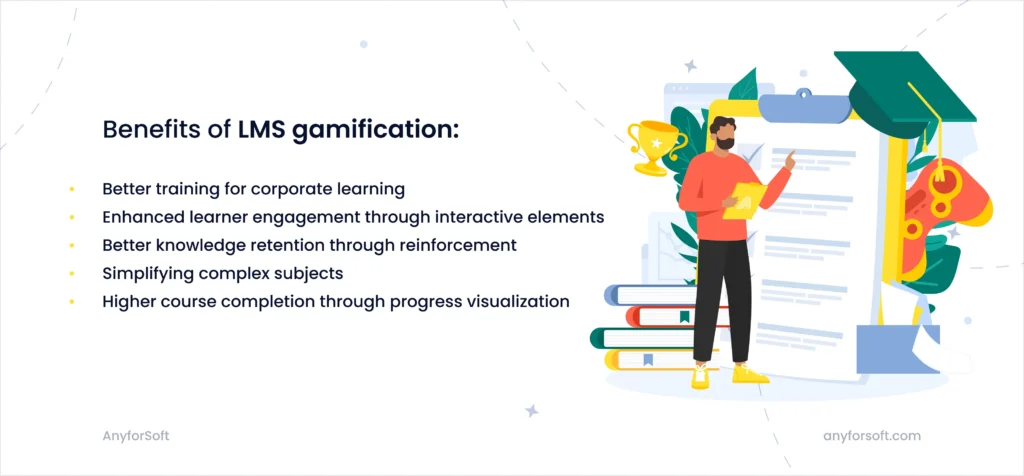
Must-Have Game Design Elements for Your LMS
To gamify your learning management system, add these elements.
Badges that recognize real progress
Achievement badges give users a sense of accomplishment and motivate further learning activities. Design badges that recognize meaningful milestones, not just participation.
For example, TalentLMS offers both activity and learning badges to incentivize platform usage:
- Activity badges reward frequent platform usage and logins.
- Learning badges recognize course completion and skill mastery.
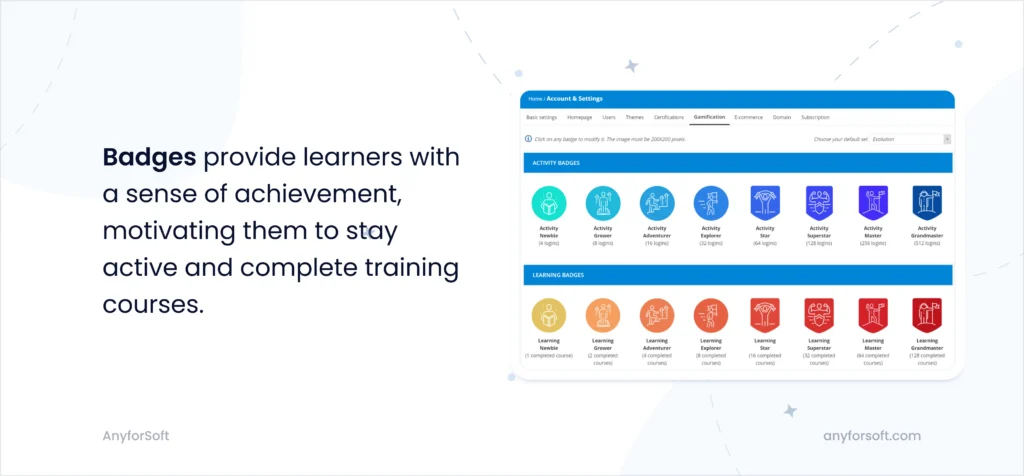
You can introduce similar mechanics to increase employee engagement and retention while making badges represent real achievement.
Points systems that drive meaningful actions
When our progress is measurable, it drives us for better results, isn’t is? Points are great motivators when tied to valuable learning behaviors.
Assign point values to different learning activities: course completion, quiz mastery, peer interaction, skill demonstrations. The possibilities are endless – you can award points for any activity that supports your training goals.
TalentLMS lets course creators and tutors decide when and how many points are awarded to users, so you can tailor to your specific learning programs.
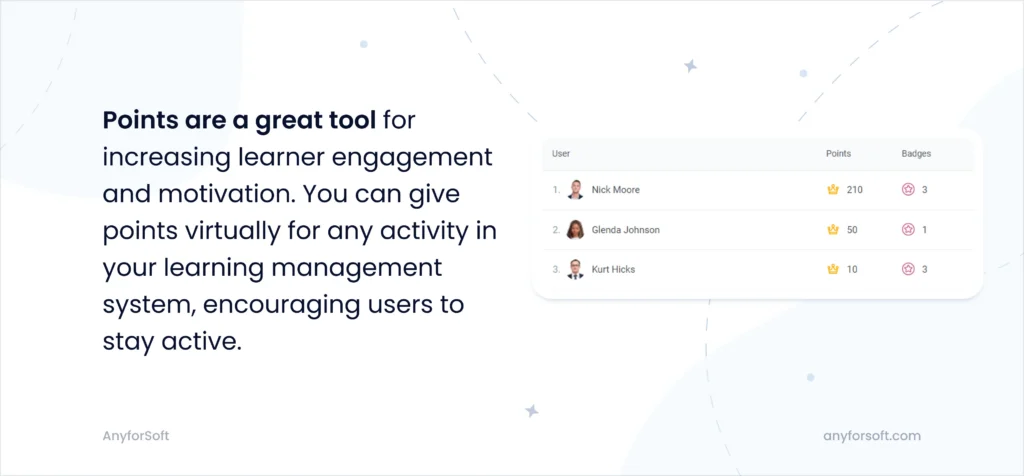
Whether you go for a ready-made learning management system or custom LMS development, a robust points feature is key to keeping learners engaged.
Leaderboards that encourage competition
Badges and leaderboards serve two purposes in your gamification system. They introduce healthy competition that makes employees want to beat their colleagues and provide valuable data on learner progress.
You can use leaderboards to measure training effectiveness and identify top performers. For training employees, leaderboards help you see how newbies are progressing and make informed decisions about role assignments based on learning results. iSpring Learn shows great leaderboard implementation that balances competition with social learning opportunities.

By the way, we already discussed leaderboards in our article on LMS reporting—make sure to read it if you haven’t already.
Levels and progression systems
Levels give users clear progress indicators and let you structure learning technology properly. There are many ways to use this feature effectively.
Upgrade user levels when they earn a certain number of points, complete specific courses, or earn rewards for consistent engagement. You can display leaderboards with the top-level learners, go beyond simple point-based rankings.
Use levels to control learning paths by restricting access to advanced courses until learners have completed foundational work. This way, you streamline the e-learning experience so users don’t try material that’s too hard and get discouraged. TalentLMS, SAP Litmos, and other gamification system solutions use level mechanics to keep challenge progression in check.
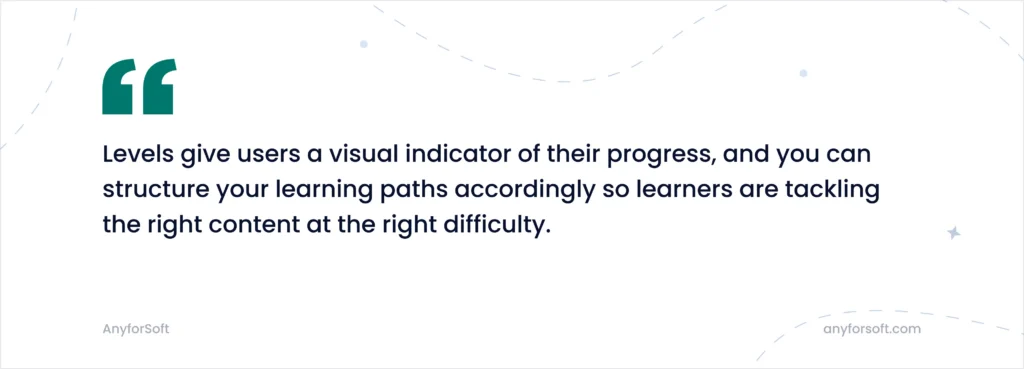
Instant feedback that guides learning
Instant feedback turns mistakes into learning opportunities. Implement instant response systems that explain why answers are correct or incorrect, so learners understand concepts not just memorize responses.
Good feedback systems provide contextual hints during tough sections, adaptive difficulty based on performance patterns, and personalized improvement recommendations that keep learners moving forward.

Storyline integration for immersive experiences
Narrative structures help learners connect emotionally with content and provide context for abstract concepts. Gamification examples that use storylines show great results when storylines mirror real workplace scenarios.
You can create learning journeys where employees navigate real-life situations, make decisions with consequences, and see how their choices impact outcomes. This bridges the gap between theoretical knowledge and practical application.
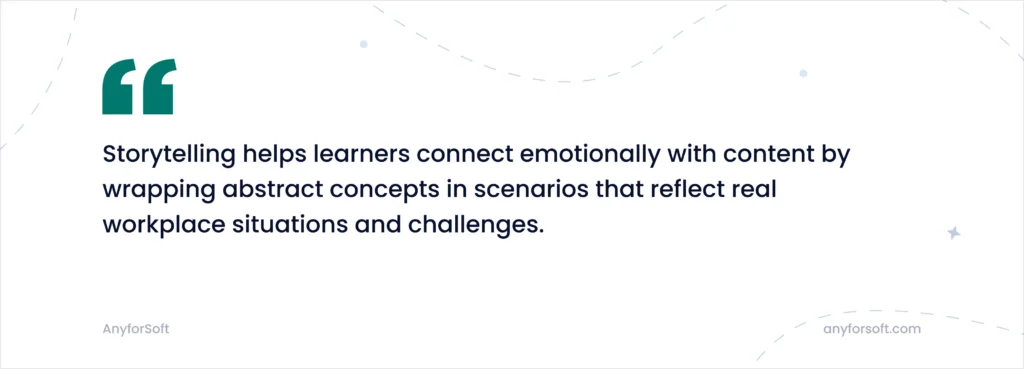
Customization for tailored experiences
LMS customization lets you configure your learning platform to your specific needs and goals. While customization isn’t a gamification feature by itself, it allows you to modify game mechanics to fit your exact requirements.
You can make experience points performance-based rather than participation-based, adjust badge requirements to reflect meaningful achievements, and modify reward systems to fit your company culture.
The more customization options your platform has, the more you can tailor the gamified experience to your needs.
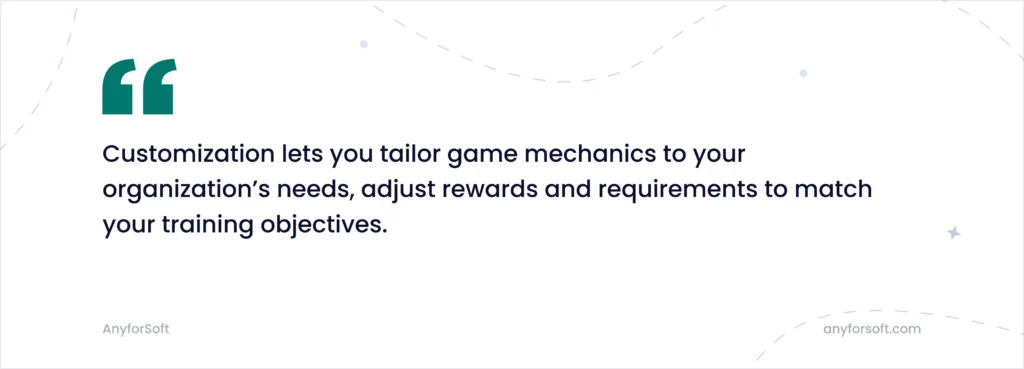
“The intelligent integration enhanced our LMS with personalized learning experiences, making it a standout solution.”
- Oleh Meleshko, CEO, Incode Group
Top Gamification LMS Software
TalentLMS
TalentLMS has gamification features, including badges, points, and levels to motivate learners through their training. Known for ease of use and scalability across all sizes of organizations.
Key features:
- Configurable point and badge systems with many options.
- Advanced analytics for engagement and learning outcomes.
- Mobile-friendly interface for a consistent e-learning experience.
- Integration with existing HR and business systems.
Classcraft
Classcraft gamifies the classroom experience with RPG-like elements where students form teams, earn rewards for doing learning activities, and collaborate on quests and challenges.
Key features:
- Team-based learning that promotes social learning and collaboration.
- Behaviour tracking beyond grades.
- Parent integration for K-12 schools.
- Teacher collaboration tools for coordinated lessons.
Kahoot!
While not a traditional LMS, Kahoot! shows how competitive elements turn regular assessments into engaging learning activities. It has multiple gamification features, including points and badges, leaderboards, and immersive visuals.
Key features:
- Real-time multiplayer competitions that boost engagement.
- Music and visual effects that enhance the learning atmosphere.
- Corporate training modules with detailed analytics and reporting.
- Seamless integration with presentation software for classroom use.
Moodle
Moodle is an open-source LMS where educators can implement gamification systems through plugins like Level Up! and Gamification. They can add game-like elements to online courses to motivate learners and deliver personalized experiences.
Key features:
- Huge plugin ecosystem for custom gamification features.
- Open-source so you can customize learning technology.
- Strong community support with regular updates.
- SCORM compliant, so content is compatible across platforms.
Docebo
Enterprise-focused platform with advanced gamification features and AI-driven personalization. Great for organizations that need scalability and advanced integrations.
Key features:
- AI-powered content recommendations based on individual learning patterns.
- Advanced social learning feature,s including forums and peer mentoring systems.
- Mobile-first design for modern workforce training needs.
- API for custom integrations with existing business systems.
SAP Litmos
Robust enterprise solution with gamification systems and extensive compliance tracking and detailed reporting for corporate learning.
Key features:
- Pre-built content libraries for common training employees scenarios.
- Certification management with automated renewal tracking.
- Multi-language support for global training across diverse teams.
- Analytics to measure ROI and business impact of learning programs.
iSpring Suite
Comprehensive authoring and delivery platform with built-in gamification features for rapid content development and deployment.
Key features:
- PowerPoint-based authoring tools for familiar content creation workflows.
- No coding or technical skills required for advanced interaction templates.
- Built-in screen recording for software training scenarios.
- Responsive design for a consistent training experience across all devices.
Adobe Captivate
Professional authoring tool with branching scenarios and gamified experience for complex training needs.
Key features:
- VR/AR content creation for immersive learning technology experiences.
- Advanced branching logic for personalized learning paths and adaptive content.
- Analytics to track learner interactions and decision points throughout the course.
- Device-specific optimisation for best performance across platforms.
Conclusion
Gamification is a powerful way to improve training effectiveness, increase learner engagement, retain knowledge better, and get higher course completion rates. By adding game-like mechanics and elements thoughtfully, you turn boring learning activities into engaging experiences that help users absorb information better.
The key is to understand your learners and design mechanics that align with their motivations and work context. Whether you’re training employees on compliance requirements or building comprehensive skill development learning programs, gamification features provide the engagement foundation for measurable results.
AnyforSoft can help you gamify an off-the-shelf LMS or develop a custom solution for your needs. Having over 12 years of development experience, we’ve created dozens of solutions for the e-learning industry that combine proven learning technology with user user-friendly experience.
Ready to change your training approach? Contact us today, and let’s create a gamified experience that learners will love to use and achieve your training goals.





